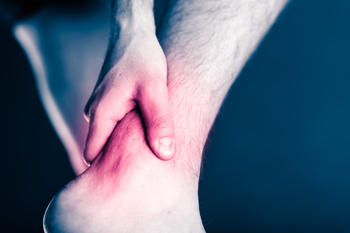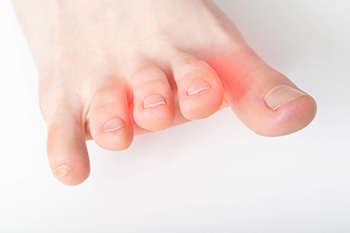Connect With Us
Blog
Items filtered by date: May 2023
Tendonitis of the Feet and Ankles

Tendonitis of the feet and ankles is a frequent cause of foot pain and swelling. It occurs when the tendons that are attached to the leg, foot, or ankle bones become inflamed from injury or overuse. Different areas of the foot and ankle can be affected by tendonitis, including the back of the ankle, the side along the big toe, and the top of the foot. With this condition, pain typically subsides with rest, only to resume with movement. Tendonitis of the foot and ankles can be incurred from sports injuries, abnormal foot structure, trauma to the feet or ankles, and pre-existing health conditions. If you suffer from tendon pain in your feet or ankles, it is suggested that you contact a podiatrist who can properly diagnose this condition, and provide effective treatment.
Foot and ankle trauma is common among athletes and the elderly. If you have concerns that you may have experienced trauma to the foot and ankle, consult with Arthur Segall, Jr., DPM from Segall Foot and Ankle. Our doctor will assess your condition and provide you with quality foot and ankle treatment.
Foot and ankle trauma cover a range of injuries all over the foot; common injuries include:
- Broken bones
- Muscle strains
- Injuries to the tendons and ligaments
- Stress fractures
Symptoms
Symptoms of foot and ankle injuries vary depending on the injury, but more common ones include:
- Bruising
- Inflammation/ Swelling
- Pain
Diagnosis
To properly diagnose the exact type of injury, podiatrists will conduct a number of different tests. Some of these include sensation and visual tests, X-rays, and MRIs. Medical and family histories will also be taken into account.
Treatment
Once the injury has been diagnosed, the podiatrist can than offer the best treatment options for you. In less severe cases, rest and keeping pressure off the foot may be all that’s necessary. Orthotics, such as a specially made shoes, or immobilization devices, like splints or casts, may be deemed necessary. Finally, if the injury is severe enough, surgery may be necessary.
If you have any questions, please feel free to contact our offices located in Plantation, FL Ft. Lauderdale, F . We offer the newest diagnostic and treatment technologies for all your foot care needs.
High Heels and Morton’s Neuroma

A compressed or irritated growth that is found between the third and fourth toes can represent a foot condition known as Morton’s neuroma. It is considered to be benign, despite how painful it can be. Wearing shoes that do not have enough room for the toes to move freely can be a common cause for this condition to occur. High heels fit into this category, and women who frequently wear this type of shoe may be affected. People who are afflicted with this ailment often feel they have a small pebble in their shoe or sock, typically on the ball of the foot. This part of the foot is used for standing and walking, which can cause constant pain. Patients who notice the beginning signs of Morton’s neuroma may find temporary relief when better shoes are worn. For more severe cases, it is suggested that you consult with a podiatrist who can provide you with permanent relief solutions.
Morton’s neuroma is a very uncomfortable condition to live with. If you think you have Morton’s neuroma, contact Arthur Segall, Jr., DPM of Segall Foot and Ankle. Our doctor will attend to all of your foot care needs and answer any of your related questions.
Morton’s Neuroma
Morton's neuroma is a painful foot condition that commonly affects the areas between the second and third or third and fourth toe, although other areas of the foot are also susceptible. Morton’s neuroma is caused by an inflamed nerve in the foot that is being squeezed and aggravated by surrounding bones.
What Increases the Chances of Having Morton’s Neuroma?
- Ill-fitting high heels or shoes that add pressure to the toe or foot
- Jogging, running or any sport that involves constant impact to the foot
- Flat feet, bunions, and any other foot deformities
Morton’s neuroma is a very treatable condition. Orthotics and shoe inserts can often be used to alleviate the pain on the forefront of the feet. In more severe cases, corticosteroids can also be prescribed. In order to figure out the best treatment for your neuroma, it’s recommended to seek the care of a podiatrist who can diagnose your condition and provide different treatment options.
If you have any questions, please feel free to contact our offices located in Plantation, FL Ft. Lauderdale, F . We offer the newest diagnostic and treatment technologies for all your foot care needs.
Foot Pain and Hip Pain

If a person is living with foot pain, there may be any number of potential causes. For example, a person might have a condition such as plantar fasciitis or heel spurs that is causing the pain. Additionally, foot pain has interesting connections and relationships to other parts of the body that may be affected. Specifically, foot pain can sometimes be linked with hip pain. The reason for this is that the interaction between the foot and the hip, as well as the knee, form a kinetic chain, responsible for facilitating motion. Also, since the feet are the very foundation of the body, a problem with the feet could also lead to a problem with hip pain. Importantly, the hips and the feet are interconnected and one ought to care for both of these important body parts. If you are someone currently living with hip or foot pain, it is suggested that you contact a podiatrist today.
Foot Pain
Foot pain can be extremely painful and debilitating. If you have a foot pain, consult with Arthur Segall, Jr., DPM from Segall Foot and Ankle. Our doctor will assess your condition and provide you with quality foot and ankle treatment.
Causes
Foot pain is a very broad condition that could be caused by one or more ailments. The most common include:
- Bunions
- Hammertoes
- Plantar Fasciitis
- Bone Spurs
- Corns
- Tarsal Tunnel Syndrome
- Ingrown Toenails
- Arthritis (such as Gout, Rheumatoid, and Osteoarthritis)
- Flat Feet
- Injury (from stress fractures, broken toe, foot, ankle, Achilles tendon ruptures, and sprains)
- And more
Diagnosis
To figure out the cause of foot pain, podiatrists utilize several different methods. This can range from simple visual inspections and sensation tests to X-rays and MRI scans. Prior medical history, family medical history, and any recent physical traumatic events will all be taken into consideration for a proper diagnosis.
Treatment
Treatment depends upon the cause of the foot pain. Whether it is resting, staying off the foot, or having surgery; podiatrists have a number of treatment options available for foot pain.
If you have any questions, please feel free to contact our offices located in Plantation, FL Ft. Lauderdale, F . We offer the newest diagnostic and treatment technologies for all your foot care needs.
Get Professional Care for a Broken Foot or Ankle
Simple Steps That Can Help Prevent Falling

A staggering number of seniors fall every year, and their feet may become injured. A broken foot or toe can wreak havoc in enjoying daily activities, and there are effective fall prevention methods that can be implemented that may help to avoid this. The majority of falls occur in the living environment, and making simple changes can help to avoid mishaps. These can include removing worn rugs, clearing clutter, and improving existing lighting. It is beneficial to have routine physical and eye examinations, which is helpful in updating medication and eyeglasses. Additionally, many people install grab bars in the toilet and shower area, as well as stepping on non-slip bath mats. Seniors become fearful after falling, and this may be eliminated when fall prevention methods are put into place. If you would like more information about how falling can affect the feet, it is suggested that you consult with a podiatrist who can provide expert advice on this topic.
Preventing falls among the elderly is very important. If you are older and have fallen or fear that you are prone to falling, consult with Arthur Segall, Jr., DPM from Segall Foot and Ankle. Our doctor will assess your condition and provide you with quality advice and care.
Every 11 seconds, an elderly American is being treated in an emergency room for a fall related injury. Falls are the leading cause of head and hip injuries for those 65 and older. Due to decreases in strength, balance, senses, and lack of awareness, elderly persons are very susceptible to falling. Thankfully, there are a number of things older persons can do to prevent falls.
How to Prevent Falls
Some effective methods that older persons can do to prevent falls include:
- Enrolling in strength and balance exercise program to increase balance and strength
- Periodically having your sight and hearing checked
- Discuss any medications you have with a doctor to see if it increases the risk of falling
- Clearing the house of falling hazards and installing devices like grab bars and railings
- Utilizing a walker or cane
- Wearing shoes that provide good support and cushioning
- Talking to family members about falling and increasing awareness
Falling can be a traumatic and embarrassing experience for elderly persons; this can make them less willing to leave the house, and less willing to talk to someone about their fears of falling. Doing such things, however, will increase the likelihood of tripping or losing one’s balance. Knowing the causes of falling and how to prevent them is the best way to mitigate the risk of serious injury.
If you have any questions, please feel free to contact our offices located in Plantation, FL Ft. Lauderdale, F . We offer the newest diagnostic and treatment technologies for all your foot care needs.
Causes of Cuboid Syndrome

People who have pain on the outside of their ankle may have cuboid syndrome. This ailment is defined as the cuboid bone moving outward while the heel bone moves inward. It is a foot condition that can be caused by twisting the ankle or from stepping off of a curb in the wrong way unexpectedly. It may also develop from running on hard or uneven surfaces or from wearing shoes that do not provide adequate support. The pain may increase when body weight is put on that side of the foot and may radiate to the other areas of the foot. Additional symptoms can consist of a reduced range of motion in the ankle and surrounding areas, and the toes may feel weak that are closest to the injury. Some patients may alter their gait, or walking style, to accommodate the pain by limping or swaying from side to side. If you have pain in this part of your foot, it is suggested that you speak with a podiatrist who can confirm cuboid syndrome and offer correct treatment options.
Cuboid syndrome, also known as cuboid subluxation, occurs when the joints and ligaments near the cuboid bone in the foot become torn. If you have cuboid syndrome, consult with Arthur Segall, Jr., DPM from Segall Foot and Ankle. Our doctor will assess your condition and provide you with quality foot and ankle treatment.
Cuboid syndrome is a common cause of lateral foot pain, which is pain on the outside of the foot. The condition may happen suddenly due to an ankle sprain, or it may develop slowly overtime from repetitive tension through the bone and surrounding structures.
Causes
The most common causes of cuboid syndrome include:
- Injury – The most common cause of this ailment is an ankle sprain.
- Repetitive Strain – Tension placed through the peroneus longus muscle from repetitive activities such as jumping and running may cause excessive traction on the bone causing it to sublux.
- Altered Foot Biomechanics – Most people suffering from cuboid subluxation have flat feet.
Symptoms
A common symptom of cuboid syndrome is pain along the outside of the foot which can be felt in the ankle and toes. This pain may create walking difficulties and may cause those with the condition to walk with a limp.
Diagnosis
Diagnosis of cuboid syndrome is often difficult, and it is often misdiagnosed. X-rays, MRIs and CT scans often fail to properly show the cuboid subluxation. Although there isn’t a specific test used to diagnose cuboid syndrome, your podiatrist will usually check if pain is felt while pressing firmly on the cuboid bone of your foot.
Treatment
Just as the range of causes varies widely, so do treatments. Some more common treatments are ice therapy, rest, exercise, taping, and orthotics.
If you have any questions, please feel free to contact our offices located in Plantation, FL Ft. Lauderdale, F . We offer the newest diagnostic and treatment technologies for all your foot care needs.

